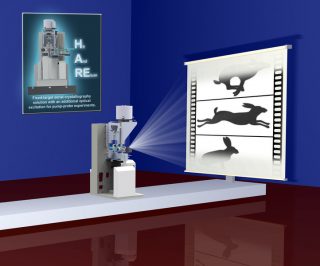Researchers from the MPSD’s Department of Atomically Resolved Dynamics at the Center for Free-Electron Laser Science, the Centre for Ultrafast Imaging (all in Hamburg), the University of Toronto in Canada and the ETH in Zurich, Switzerland, have developed a new method to watch biomolecules at work. This method not only simplifies the experiment but accelerates it so much that many snapshots can now be recorded in a single experimental session. These can then be assembled into a time-lapse sequence that shows the molecular foundations of biology.

The “hit and return” (HARE) method simplifies taking snap-shot movies of biomolecules at work. Credit: Jörg Harms / MPSD
All life is dynamic and so are its molecular building blocks. The motions and structural changes of biomolecules are fundamental to their function. However, understanding these dynamic motions at a molecular level is a formidable challenge. One method to understand them is time-resolved X-ray crystallography, where the reaction of a biological molecule is triggered and then snapshots are taken as it reacts. However, these experiments are extremely time-consuming.
Revealing structural changes
The new “hit-and-return” method is tailored to the study of biologically relevant reaction time-scales, which are on the order of milliseconds to seconds or even minutes. These time-scales are of particular interest to biologists and pharmaceutical researchers as they often reveal the structural changes relevant to a particular biological function or the turnover of a drug. Combining the highly intense micro-focused X-ray beams available on beamline P14 of the European Molecular Biology Laboratory (EMBL) and beamline P11 at DESY (Deutsches Elektronen Synchrotron) with the hit and return method allowed the team to interrogate an important enzyme for the breakdown of manmade pollutants in action, on the millisecond time-scale.
Key to their success was that the “hit-and return” method makes the whole experiment a lot faster than previous approaches. While a single structural snapshot could previously only be obtained after several hours of data collection, the new “hit-and-return” method provides about 1 time-point per hour, irrespective of the delay-time. The method works so well that it is now possible to collect many snapshots consecutively, letting the researchers record a time-lapse sequence of the structural changes during a biomolecule’s complete reaction within a single 24-hour experiment.
Great potential for radiation sources
Excitingly, this new method has great potential for existing and up-coming high-brilliance synchrotron radiation sources. Its far less time-consuming nature will allow many more researchers to carry out time-resolved crystallography studies. Together with EMBL and the Universität Hamburg, with the support of the German Department for Education and Research (BMBF), the “hit-and-return” method is already being implemented as a standard sample environment for the new time-resolved macromolecular crystallography end station on the EMBL beamline P14 at the PETRA III synchrotron at DESY.
The team anticipates that many more important insights about biochemical processes will come about by applying such cutting-edge technologies. A deeper understanding of these processes will, in turn, help to answer some of the most pressing questions about our health and the environment. Text: MPSD, ed.
Citation:
Eike C. Schulz et al.
“The hit-and-return system enables efficient time-resolved serial synchrotron crystallography”
Nature Methods 15, 901–904 (2018)
DOI: 10.1038/s41592-018-0180-2

